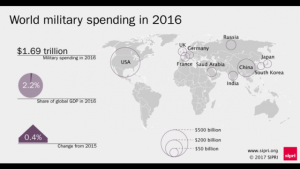The United States easily tops the world’s rankings on annual military spending – and by a large margin.
The United States devotes more money to the military than the next eight highest spending countries combined, most of whom are U.S. allies.
In total, the U.S. military budget is $611 billion, three times as much the next highest spender – China with an estimated $215 billion. Russian, by comparison, spends of $69.2 billion a year, almost nine times less than the United States.
The figures for 2016 were produced by the authoritative Stockholm International Peace Research Institute (SIPRI) in a study released in April.

Despite the clear advantage, the Trump Administration does not think the United States is spending enough.
In his first 100 days, President Donald Trump has recommended adding $30 billion to the Pentagon budget in fiscal year 2017 and a $52 billion increase from the previous year’s level in the fiscal year 2018 budget.
As with almost every military move the President makes – attacking Syria with 59 cruise missiles, claiming to send the aircraft carrier U.S.S. Carl Vinson steaming to waters around North Korea, dropping a huge conventional bomb in Afghanistan – these swollen budgets are meant to demonstrate U.S. toughness and resolve. The specifics do not matter; the symbolism does.
This symbolism relies on dangerous logic: more Pentagon spending means more U.S. security. This is wrong for several reasons. First, increasing spending without a coherent defense strategy syphons federal funds from other critical national security priorities while failing to address critical national security threats. Congress’s annual habit of funding pet projects that the Pentagon does not want is a clear example of this principle.
Adding to the problem is that there is limited accountability for U.S. Pentagon spending. The Pentagon is the only major federal agency to never pass a legally-mandated audit, meaning the agency can’t fully account for the more than $600 billion it receives every year.
At the same time, billions of dollars are lost annually on wasteful programs. Without well-defined defense priorities, the Pentagon buys systems without clear military benefits because there is no pressure to make tough choices between competing programs.
An example of failing to make tough choices is the current “All The Above” approach to rebuilding the U.S. nuclear weapons arsenal. The Trump Administration, following the script left behind by the Obama Administration, is planning to spend up to $1 trillion over the next three decades for refurbishing our nuclear weapons: new intercontinental ballistic missiles, strategic nuclear submarines, strategic bombers, nuclear cruise missiles, nuclear weapons and command and control procedures. This exceeds what the United States needs for nuclear deterrence, creating increased budgetary pressure that will peak in the mid-2020’s. During this time, the cost to rebuild and maintain the U.S. nuclear program will grow annually from $17 billion to $27 billion in FY 2027, a 56% increase in real terms.
These programs, along with other big ticket items like the F-35 and the Navy’s new shipbuilding plan, will create considerable budgetary pressure in future years. That is why it is so important to keep the U.S. defense budget in perspective as it continues to grow. As then-Secretary of Defense Robert Gates said, “If the Department of Defense can’t figure out a way to defend the United States on a budget of more than half a trillion dollars a year, then our problems are much bigger than anything that can be cured by buying a few more ships and planes.”
Instead of further increasing spending, the United States should develop a coherent defense strategy and prioritize accountability within the $600+ billion defense budget to make sure every dollar spent is being used to improve U.S. security.
